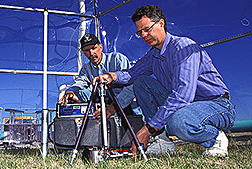This page has been archived and is being provided for reference purposes only. The page is no longer being updated, and therefore, links on the page may be invalid.
More Forage, But Less Filling
By Rosalie Marion BlissJanuary 18, 2005
Continued elevated carbon dioxide concentrations in the atmosphere may reduce forage quality among the world's grasslands and lead to reduced weight gain among animals, according to Agricultural Research Service scientists and cooperators. Their five-year study was published in the journal Ecological Applications.
Plant physiologist Jack A. Morgan led the study with ARS colleagues and cooperators at Colorado State University. Morgan heads the ARS Rangeland Resources Research Unit in Fort Collins, Colo.
Atmospheric concentrations of carbon dioxide have been rising steadily during the last 150 years. The compound is considered a major greenhouse gas because of its ability to trap heat near the Earth's surface. Fossil-fuel burning, forest clearing and industrial manufacturing account for most of the increased carbon dioxide emissions.
An intergovernmental panel on climate change has estimated that atmospheric CO2 concentrations will double over today's levels by the end of the 21st century.
The experiment was conducted on native shortgrass prairie in northern Colorado. The plant community tested was characteristic of vegetation grown in semi-arid grassland for thousands of years. To simulate elevated atmospheric carbon dioxide conditions and make comparisons, the scientists used six open-top chambers. Each chamber contained more than 25 different plant species, but was dominated by three perennial native grass species.
Three of the chambers were infused with ambient air containing about 360 parts per million (ppm) carbon dioxide to model present atmospheric conditions. The other three chambers were infused with ambient air that had been injected with pure CO2 to double the amount of carbon dioxide to 720 ppm.
The scientists found that forage quality declined in all three dominant grasses under the elevated carbon dioxide conditions, due largely to lower tissue nitrogen content. Further, they found that production of the least desirable of the three dominant grasses, Stipa comata (needle-and-thread grass), significantly increased under elevated CO2, while production in the two higher-quality grasses remained unchanged.
ARS is the U.S. Department of Agriculture's chief scientific agency.

